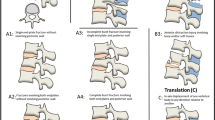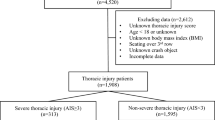Abstract
Background
While most motor vehicle crash (MVC)-related injuries have been decreasing, one study showed increases in MVC-related spinal fractures from 1994 to 2002 in Wisconsin. To our knowledge, no studies evaluating nationwide trends of MVC-related thoracolumbar spine injuries have been published. Such fractures can cause pain, loss of functionality or even death. If the incidence of such injuries is increasing, it may provide a motive for reassessment of current vehicle safety design.
Questions/purposes
We questioned whether the incidence of thoracolumbar spine injuries increased in the United States population with time (between 1998 and 2011), and if there was an increased incidence of thoracolumbar injuries, whether there were identifiable compensatory “trade-off injury” patterns, such as reductions in sacropelvic injuries.
Patients and Methods
Institutional review board approval was obtained for retrospective review of three national databases: the National Trauma Databank® (NTDB®), 2002–2006, National Automotive Sampling System (NASS), 2000–2011, and National Inpatient Sample (NIS), 1998–2007. In each database, the total number of MVC-related injuries and the number of MVC-related thoracolumbar injuries per year were identified using appropriate Abbreviated Injury Scale (AIS) or ICD-9 codes. Sacropelvic injuries also were identified to evaluate their potential as trade-off injuries. Poisson regression models adjusting for age were used to analyze trends in the data with time.
Results
All databases showed increases in MVC-related thoracolumbar spine injuries when adjusting for age with time. These age-adjusted relative annual percent increases ranged from 8.22% (95% CI, 5.77%–10.72%; p < 0.001) using AIS of 2 or more (AIS2 +) injury codes in the NTDB®, 8.59% (95% CI, 5.88%-11.37%; p < 0.001) using ICD-9 codes in the NTDB®, 8.12% (95% CI, 7.20%–9.06%; p < 0.001) using ICD-9 codes in the NIS, and 8.10 % (95% CI 5.00%–11.28%; p < 0.001) using AIS2+ injury codes in the NASS. As these thoracolumbar injuries have increased, there has been no consistent trend toward a compensatory reduction in terms of sacropelvic injuries.
Conclusions
While other studies have shown that rates of many MVC-related injuries are declining with time, our data show increases in the incidence of thoracolumbar injury. Although more sensitive screening tools likely have resulted in earlier and increased recognition of these injuries, it cannot be stated for certain that this is the only driver of the increased incidence observed in this study. As seatbelt use has continued to increase, this trend may be the result of thoracolumbar injuries as trade-offs for other injuries, although in our study we did not see a compensatory decrease in sacropelvic injuries. Investigation evaluating the root of this pattern is warranted.



Similar content being viewed by others
References
Abbas AK, Hefny AF, Abu-Zidan FM. Seatbelts and road traffic collision injuries. World J Emerg Surg. 2011;6:18.
Association for the Advancement of Automotive Medicine. The Abbreviated Injury Scale. Available at: http://www.aaam.org/about-ais.html. Accessed January 7, 2014.
Brandt MM, Wahl WL, Yeom K, Kazerooni E, Wang SC. Computed tomographic scanning reduces cost and time of complete spine evaluation. J Trauma. 2004;56:1022–1026; discussion 1026–1028.
Brown CV, Antevil JL, Sise MJ, Sack DI. Spiral computed tomography for the diagnosis of cervical, thoracic, and lumbar spine fractures: its time has come. J Trauma. 2005;58:890–895; discussion 895–896.
Committee on Trauma; American College of Surgeons. National Trauma Data Bank. Available at: http://www.facs.org/trauma/ntdb/index.html. Accessed July 30, 2014.
Defino HL, Canto FR. Low thoracic and lumbar burst fractures: radiographic and functional outcomes. Eur Spine J. 2007;16:1934–1943.
Dischinger PC, Read KM, Kufera JA, Kerns TJ, Burch CA, Jawed N, Ho SM, Burgess AR. Consequences and costs of lower-extremity injuries. Annu Proc Assoc Adv Automot Med. 2004; 48:339–353. Available at: http://www.ntis.gov. Accessed July 10, 2014.
Griffey RT, Ledbetter S, Khorasani R. Changes in thoracolumbar computed tomography and radiography utilization among trauma patients after deployment of multidetector computed tomography in the emergency department: J Trauma. 2007;62:1153–1156.
Hauser CJ, Visvikis G, Hinrichs C, Eber CD, Cho K, Lavery RF, Livingston DH. Prospective validation of computed tomographic screening of the thoracolumbar spine in trauma. J Trauma. 2003;55:228–234; discussion 234–235.
HCUP Databases. Healthcare Cost and Utilization Project (HCUP). June 2014. Agency for Healthcare Research and Quality, Rockville, MD. Available at: http://www.hcup-us.ahrq.gov/databases.jsp. Accessed July 30, 2014.
Hodson-Walker NJ. The value of safety belts: a review. Can Med Assoc J. 1970;102:391–393.
Kahane C. Effectiveness of pretensioners and load limiters for enhancing fatality reduction by seat belts. (Report No. DOT HS 811 835). Washington DC: National Highway Traffic Safety Administration. Available at: http://www-nrd.nhtsa.dot.gov/Pubs/811835.pdf. Accessed June 27, 2014.
McLain RF. Functional outcomes after surgery for spinal fractures: return to work and activity. Spine (Phila Pa 1976). 2004;29:470–477; discussion Z6.
National Center for Health Statistics (NCHS) and the Centers for Medicare and Medicaid Services. Centers for Disease Control and Prevention. The International Classification of Diseases, Ninth Revision, Clinical Modification (ICD-9-CM). Available at: http://www.cdc.gov/nchs/icd/icd9cm.htm. Accessed June 27, 2014.
National Highway Traffic Safety Administration. Traffic Safety Facts. Available at: http://www-nrd.nhtsa.dot.gov/Pubs/811172.pdf . Accessed July 30, 2014.
National Highway Traffic Safety Administration, National Automotive Sampling System (NASS). Available at: http://www.nhtsa.gov/NASS. Accessed January 7, 2014.
Post RB, van der Sluis CK, Leferink VJ, Dijkstra PU, ten Duis HJ. Nonoperatively treated type A spinal fractures: mid-term versus long-term functional outcome. Int Orthop. 2009;33:1055–1060.
Sheridan R, Peralta R, Rhea J, Ptak T, Novelline R. Reformatted visceral protocol helical computed tomographic scanning allows conventional radiographs of the thoracic and lumbar spine to be eliminated in the evaluation of blunt trauma patients. J Trauma. 2003;55:665–669.
Starnes M. Trends in non-fatal traffic injuries: 1996–2005. National Highway Traffic Safety Administration. Available at: http://www-nrd.nhtsa.dot.gov/pubs/810944.pdf. Accessed December 18, 2013.
Wang MC, Pintar F, Yoganandan N, Maiman DJ. The continued burden of spine fractures after motor vehicle crashes. J Neurosurg Spine. 2009;10:86–92.
Acknowledgments
NTDB® data were provided by the Committee on Trauma, American College of Surgeons, NTDB® Version 7.1 Chicago, IL, 2007. The content reproduced from the NTDB® remains the full and exclusive copyrighted property of the American College of Surgeons. The American College of Surgeons is not responsible for any claims arising from works based on the original data, text, tables, or figures.
Author information
Authors and Affiliations
Corresponding author
Additional information
Each author certifies that he or she, or a member of his or her immediate family, has no funding or commercial associations (eg, consultancies, stock ownership, equity interest, patent/licensing arrangements, etc) that might pose a conflict of interest in connection with the submitted article.
All ICMJE Conflict of Interest Forms for authors and Clinical Orthopaedics and Related Research editors and board members are on file with the publication and can be viewed on request.
Each author certifies that his or her institution approved the human protocol for this investigation, that all investigations were conducted in conformity with ethical principles of research, and that informed consent for participation in the study was not required.
About this article
Cite this article
Doud, A.N., Weaver, A.A., Talton, J.W. et al. Has the Incidence of Thoracolumbar Spine Injuries Increased in the United States From 1998 to 2011?. Clin Orthop Relat Res 473, 297–304 (2015). https://doi.org/10.1007/s11999-014-3870-9
Received:
Accepted:
Published:
Issue Date:
DOI: https://doi.org/10.1007/s11999-014-3870-9




